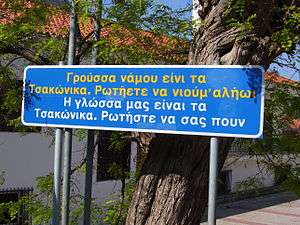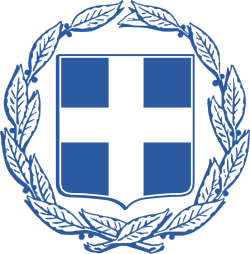Tsakonia
Tsakonia (Greek: Τσακωνιά) or the Tsakonian region (Τσακωνικός χώρος) refers to the small area in the eastern Peloponnese where the Tsakonian language is spoken. It is not a formally defined political entity of the modern Greek state, being more akin to such vague regional constructions as "Dixie" in the United States or the "West Country" in England.
Extent
In his Brief Grammar of the Tsakonian Dialect published in 1951, Prof. Thanasis Costakis defines Tsakonia as the area from the town of Agios Andreas in Kynouria south to Leonidio and Tyros and inland as far as Kastanitsa and Sitaina, but asserts that in former times the Tsakonian-speaking area extended as far as Cape Malea in eastern Laconia. The principal town in Tsakonia at this time was Prastos, which benefited from a special trading privilege granted by the authorities in Constantinople. Prastos was burned by Ibrahim Pasha in the Greek War of Independence and was abandoned, with many of its residents fleeing to the area around Leonidio and Tyros or other spots on the Argolic Gulf.
Some early commentators seem to have confused the speech of Maniot dialect speakers with true Tsakonian, demonstrating the flexible nature of the term.
The actual Tsakonian speech community has shrunk greatly since Brief Grammar was published, but the area delineated by Costakis is still considered "Tsakonia" due to the preservation of certain cultural traits such as the Tsakonian dance and unique folk costumes.
The Tsakonian speaking region was once much more widespread than it was at the time of Brief Grammar; Evliya Celebi noted in 1668 that the village of Vatika, far south of Leonidio, was Tsakonian; however that place would later be resettled by Arvanites; the Chronicle of Morea (14th century) furthermore indicates that Tsakonian was spoken in Cynuria, which is now part of Arcadia but was once considered to be in the northeast of Laconia.[1] The original Tsakonian region may have consisted of the entire eastern half of Laconia.[1]
History

The term Tsakonas or Tzakonas first emerges in the writings of Byzantine chroniclers who derive the ethnonym from a corruption of Lakonas, a Laconian/Lacedaemonian (Spartan)—a reference to the Doric roots of the Tsakonian language[2] and the people's very late conversion to Christianity in the 9th century and practice of traditional Hellenic customs, a fact which correlated with their isolation from mainstream medieval Greek society.[3]. What is often considered the first reference to Tsakonians is a note from around 950 by Constantine Porphyrogenitus in his De Arte Imperiando, "the inhabitants of the district of Main... are of the older Greeks, who are to this day called Hellenes (pagans) by the locals for being pagans in time past and worshippers of idols, like the Hellenes of old, and were baptised and became Christians during the reign of the late Basil (867–886)", with Maina in his usage typically interpreted to instead mean Tsakonia[3][4]
The Tsakonians are thought to have been often border guards in the Byzantine military, judging by the number of references to τζάκωνες and τζέκωνες playing such roles in Byzantine Greek writings.[3] The first reference to their "barbaric" speech being unintelligible to Koine Greek dates to the 15th century.[3]
According to the Byzantine historian George Pachymeres, some Tsakonians were resettled by the Byzantine emperor Michael VII Ducas in Propontis. This was part of their compensation for serving as marines in the Byzantine Navy.[5]:737 They and the Peloponnesian Gasmouloi, who served in the same role, were dismissed from service by Michael's successor, Andronicus II, who made large reductions in the naval force, preferring to rely on Genoese mercenaries.[5]:747 They lived in the villages of Vatka and Havoutsi, where the Gösen River (Aesepus) empties into the sea. However, based on the preservation of features common to both Propontis and the Peloponnesian dialects, Prof. Thanasis Costakis thinks that the date of settlement must have been several centuries later.
Population
| Total population | |
|---|---|
| Unknown | |
| Regions with significant populations | |
| Greece, United States, Australia | |
| Languages | |
| Tsakonian | |
| Religion | |
| Greek Orthodoxy | |
| Related ethnic groups | |
| Maniots, Sarakatsani, other Greeks |
The Tsakonians (Greek: Τσάκωνες Tsákones) are a Greek ethnolinguistic group who historically speak the Tsakonian dialect and have certain peculiar cultural traditions, such as the Tsakonian dance. Today, the dialect is critically endangered.
Tsakonians in later time were known for their masonry skills; many were also shepherds. A common practice was for a small crew of men under a mastora to leave their village after the feast of Saint Demetrius and to return at Easter. They would travel as far as Attica doing repairs and white-washing houses. The Tsakonian village of Kastanitsa was known for its chestnuts and derives its name from the Greek word for the nut.[6]:13
References
- Nicholas 2019, p. 20
- William Miller. The Latins in the Levant: A History of Frankish Greece 1204–1566. Cambridge, Speculum Historiale, 1908. p. 4.
- Nicholas 2019, p. 21
- Original from Porphyrogenitus: Ἱστέον ὅτι οἱ τοῦ κάστρου τῆς Μαΐνης οἰκήτορες οὐκ εἰσὶν ἀπὸ τῆς γενεᾶς τῶν προρρηθέντων Σκλάβων, ἀλλ’ ἐκ τῶν παλαιοτέρων Ῥωμαίων, οἳ καὶ μέχρι τοῦ νῦν παρὰ τῶν ἐντοπίων Ἕλληνες προσαγορείονται διὰ τὸ ἐν τοῖς προπαλαιοῖς χρόνοις εἰδωλολάτρας εἶναι καὶ προσκυνητὰς τῶν εἰδώλων κατὰ τοὺς παλαιοὺς Ἕλληνας, οἵτινες ἐπὶ τῆς βασιλείας τοῦ ἀοιδίμου Βασιλείου βαπτισθέντες χριστιανοὶ γεγόνασιν
- Treadgold, Warren (1997). A History of the Byzantine State and Society. Stanford, California: Stanford University Press.
- Costakis, Thanasis P (1951). Σύντομη Γραμματική της Τσακωνικής Διαλέκτου [Brief Grammar of the Tsakonian Dialect] (in Greek). Athens: Institut Français d'Athènes.
Sources
- Nicholas, Nick (2019). "A critical lexicostatistical examination of Ancient and Modern Greek and Tsakonian". Journal of applied linguistics and lexicography (1.1): 18–68.CS1 maint: ref=harv (link)
- Chrēstos D. Petakos (2003). Chrēstu D. Petaku "Tsakonia": psēphida ellēnikē istorias kai politismu. Zacharopulos. ISBN 978-960-91690-1-1.
- Hawes, Charles H. "Some Dorian Descendants?." The Annual of the British School at Athens 16 (1910): 258-280.
- kai Chavoutsi, Vatika. "ta tsakonochoria tes Propontidas." (1979).
- Bagenas, Thanos K. Thanu K. Bagena Historika Tsakōnias kai Leōnidiu. 1971.
- Pitsios, Th K. "Anthropologische Untersuchung der Bevölkerung des Peloponnes unter besonderer Berücksichtigung der Arwaniten und Tsakonen." Anthropologischer Anzeiger (1986): 215-225.

